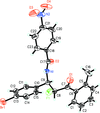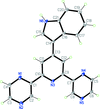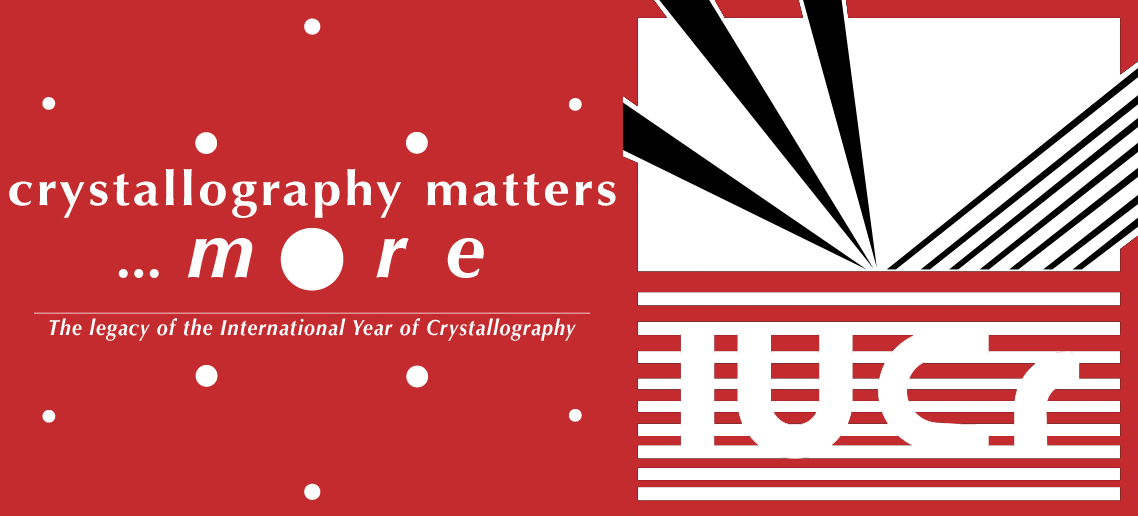issue contents
March 2018 issue

Cover illustration: In the diacetylene derivative, 5-[phenyl(pyridin-4-yl)amino]penta-2,4-diyn-1-ol, the molecules form the supramolecular dimers via hydrogen bonds between hydroxy and pyridyl groups. The dimers stack along the a axis, but the compound shows little solid-state polymerization reactivity. See: Umezono & Okuno [IUCrData (2017). 3, x180454].
inorganic compounds
Download citation


Download citation


Open  access
access
 access
accessAn (Al,Cu)13(Fe,Cu)4 phase was obtained by the high-pressure sintering (HPS) process of a mixture with stoichiometry Al78Cu15Fe7. Structure analysis suggests that Cu atoms can replace both Al and Fe atoms.
CCDC reference: 1826904
metal-organic compounds
Download citation


Download citation


Open  access
access
 access
accessIn the title compound, the central PtII atom is in an approximately square-planar configuration with the chloride ligands mutually trans. The crystal packing features N—H⋯O, C—H⋯Cl and C—H⋯O hydrogen bonds.
CCDC reference: 1827840
Download citation


Download citation


Open  access
access
 access
accessThe crystal structure of Ni(HCOO)2·2H2O has been redetermined on the basis of modern single-crystal X-ray CCD data. The redetermination confirms the previous model based on powder X-ray data, but with higher precision and accuracy.
CCDC reference: 1829415
Download citation


Download citation


Open  access
access
 access
accessThe crystal structure of a CoI hydride pincer complex with a distorted square-pyramidal coordination geometry is presented.
CCDC reference: 1831663
organic compounds
Download citation


Download citation


Open  access
access
 access
accessBoth components of the title co-crystal are generated by crystallographic twofold symmetry. In the crystal, the components are linked by O—H⋯O hydrogen bonds to generate [010] chains of alternating 2,2′-dithiobis(pyridine N-oxide) and hydrogen peroxide molecules.
CCDC reference: 1825502
Download citation


Download citation


Open  access
access
 access
accessThe title molecule, is a tetrabromo derivative of the pyranocoumarin seselin which has photobiological activity.
CCDC reference: 1826410
Download citation


Download citation


Open  access
access
 access
accessThe monoclinic unit contains the acyclic keto tautomer of the aminosugar, which is involved in an extensive hydrogen-bonding network.
CCDC reference: 753227
Download citation


Download citation


Open  access
access
 access
accessThe asymmetric unit of the title compound contains three independent molecules differing primarily in the orientations of the benzyl groups. C—H⋯N, C—H⋯π(ring) and offset π-stacking interactions stabilize the crystal structure.
CCDC reference: 1827953
Download citation


Download citation


Open  access
access
 access
accessThe title compound, was synthesized from methyl-2-methoxy benzoate. In the crystal, pairs of intermolecular bifurcated N–H(H)⋯O hydrogen bonds link the molecules to form inversion dimers, with  (6) ring motifs.
(6) ring motifs.
CCDC reference: 1819711
Download citation


Download citation


Open  access
access
 access
accessThe asymmetric unit of the title compound consists of two independent molecules, which are related to each other by a pseudo-inversion centre.
CCDC reference: 1814765
Download citation


Download citation


Open  access
access
 access
accessThe asymmetric unit of the title compound contains two independent molecules. In the crystal, C—H⋯O hydrogen bonds link the molecules into chains along [100].
CCDC reference: 1829297
Download citation


Download citation


Open  access
access
 access
accessThe dihedral angle between the triazole and thiophene rings is 4.83 (14)° while those between the triazole and toluyl rings and between the thiophene and phenyl rings are 48.42 (16) and 9.23 (13)°, respectively. An intramolecular N—H⋯O hydrogen bond closes an S(6) loop. In the crystal, molecules are stacked parallel to the a-axis direction with weak π–π interactions between adjacent thiophenyl and triazolyl groups within the stack.
CCDC reference: 1828289
Download citation


Download citation


Open  access
access
 access
accessThe asymmetric unit comprises one complete molecule and a half molecule completed by crystallographic twofold symmetry leading to Z = 12. In the crystal, neighbouring molecules are linked by pairs of N—H⋯O hydrogen bonds to form independent columns propagating parallel to the c-axis direction.
CCDC reference: 1829173
Download citation


Download citation


Open  access
access
 access
accessAll of the atoms except the C—H groups in the bromobenene ring lie on a (010) crystallographic mirror plane, with the benzene ring completed by reflection. The dihedral angle between the ring systems is constrained to be 90° by symmetry. In the crystal, molecules are linked by weak C—H⋯Br interactions in the [100] direction and paired very weak C—H⋯O interactions to the same acceptor in the [001] direction, generating (010) sheets.
CCDC reference: 1829295
Download citation


Download citation


Open  access
access
 access
accessThe dihedral angle between the nitro group and the benzene ring is 3.68 (2)°, and an intramolecular N—H⋯F hydrogen bond is observed. The crystal packing is consolidated by C—H⋯O and N—H⋯O hydrogen bonds; together, these generate [110] double chains.
CCDC reference: 1829279
Download citation


Download citation


Open  access
access
 access
accessThe structure of [1,4-bis(4-methoxyphenyl)but-3-yn-2-yl](cyano)methylamine, a subsituted cyanamide, is reported.
Download citation


Download citation


Open  access
access
 access
accessIn the title molecular salt, one of the cations is doubly protonated and one is singly protonated with charge balance achieved by three sulfonate anions. The crystal structure features interionic N—H⋯O and C—H⋯O hydrogen bonds.
CCDC reference: 1829998
Download citation


Download citation


Open  access
access
 access
accessIn the title compound, the molecules form the supramolecular dimers via hydrogen bonds between hydroxy and pyridyl groups.
CCDC reference: 1830665
Download citation


Download citation


Open  access
access
 access
accessThe title compound contains two chiral carbon centres. Its crystal structure features N—H⋯O intermolecular interactions, generating a three dimensional network structure.
CCDC reference: 1831032
Download citation


Download citation


Open  access
access
 access
accessThe structure of the title compound with a triazolyl-pyrazolyl-phenyl ring system linked to a chlorophenyl–thiazolyl–dihydropyrazolyl–bromophenyl set of rings by a bond between the dihydropyrazolyl and pyrazolyl rings is reported.
CCDC reference: 1830297
Download citation


Download citation


Open  access
access
 access
accessIn the crystal, weak C—H⋯Br interactions form chains of molecules propagating in the [010] direction.
CCDC reference: 1830522
Download citation


Download citation


Open  access
access
 access
accessIn the crystal, molecules are linked by pairs of weak N—H⋯S hydrogen bonds, forming inversion dimers.
CCDC reference: 1831308
Download citation


Download citation


Open  access
access
 access
accessThe dihedral angle between the selenadiazole and chlorophenyl rings is 16.6 (2)°. In the crystal, π–π stacking interactions between the phenyl and selenadiazole rings are observed. There is also a short Se⋯Cl contact
CCDC reference: 1831319
Download citation


Download citation


Open  access
access
 access
accessIn the title compound, the dihedral angle between the aryl rings is 6.22 (11)°. The molecular structure is stabilized by an intramolecular O—H⋯N hydrogen bond.
CCDC reference: 1831435
Download citation


Download citation


Open  access
access
 access
accessThe crystal structure of the title molecule consists of sheets of molecules linked by N—H⋯O, C—H⋯O and C—H⋯H hydrogen bonds.
CCDC reference: 1832299
Download citation


Download citation


Open  access
access
 access
accessThe molecules of the title compound are connected through N—H⋯N and C—H⋯N hydrogen bonds and aromatic π–π stacking interactions.
CCDC reference: 1832711


 journal menu
journal menu





































![[publCIF]](/logos/authorchecklist11.gif)





